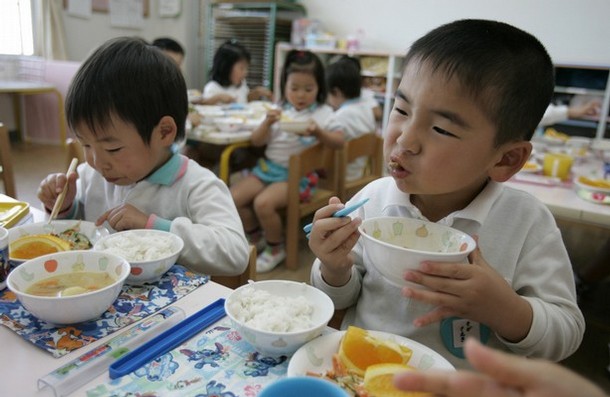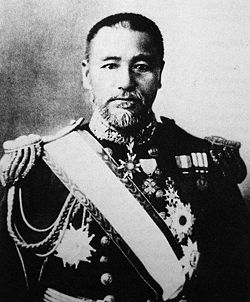Tawara Yoshifumi
Translated and introduced by Adam Lebowitz
Foiled in their attempts to change the Constitution and Article Nine in particular by the cumbersome democratic process of public consensus, the militant nationalist wing of the political establishment has set its sights on education by creating a document operationalizing changes to the Basic Law in Education. The Curricular Guidelines issued last February are a set of policy directives of unclear legal status created by the government’s General Council for Education based on suggestions from the advisory Education Rebuilding Council.
Taking their cue from the Basic Law, the color of authority for educational “reformers” is “morality” (dotoku or tokumoku). Indefinable in a legal context, the phrase “moral education” appears frequently in the reformed Basic Law, and with “patriotic education” (aikokushin-kyoiku) has become a key concept in the primary and secondary curriculum. Therefore, morality/patriotism (apparently inseparable) is not simply to be a single class but the underlying principle for the entire educational process.
Befitting the nationalist agenda – many in the “reformist” camp are members of the right wing Nihon-kai organization – the ideals are really an instrument of control. A quote from Hannah Arendt’s Totalitarianism appears piercingly cogent if “Morality” is substituted for “History” and “Nature”:
Totalitarian lawfulness defying legality and pretending to establish the direct reign of justice on earth, executes the law of History or of Nature without translating it into standards or right and wrong for individual behavior. It applies the law directly to mankind without bothering with the behavior of men.
This report was written by the head of a citizen’s group concerned with textbook reform called the Children and Textbooks Japan Network 21 (Kodomo to Kyokasho Zenkoku Netto 21). For other JF articles on government’s efforts to re-introduce nationalism to the classroom, see Japan’s Education Law Reform and the Hearts of Children by Miyake Shoko and Hammering Down the Educational Nail: Abe Revises the Fundamental law of Education by Adam Lebowitz and David McNeill. AL
In the six months since taking power, PM Fukuda Yasuo has only contributed to the education “reforms” of his predecessor. Opposed by much of the population, the Abe Shinzo-led changes to the Basic Law of Education passed in December 2006 and began the process of further reform with a School Education Bill in May 2007. Fukuda’s goal has been to apply this legislation directly to the classroom through textbook changes. He implemented general aptitude tests for the second time in April of this year despite the fact that they have been abandoned by the UK after which they were modeled. These tests can only increase competition at the student, parent, and regional level and contribute to social inequality.
Fukuda has continued Abe’s Education Rebuilding Council in a new form reducing the number of members from seventeen to ten. The head is Keio University president Anzai Yuichiro and includes the cosmetic company Shiseido’s chairman and the president of the Institute of Physical and Chemical Research (Riken). Half are also members of the General Council for Education, and Fukuda himself plus three of his cabinet (as of April 2008) are also sitting members of this body. True to its original role, the “Rebuilding Council” under Fukuda pushes the Abe agenda on education.
In February 2008 the Education and Science Ministry officially issued its New Curricular Guidelines for primary and junior high schools based on suggestions from the General Council. The Guidelines recommend a curriculum promoting “patriotic education” and the New Basic Law’s “national morals” (kokutei no tokumoku), the teaching of “myths” (shinwa) in primary-level Japanese language classes, leading students to sing the national anthem in all grades, and instructing junior high students that overseas deployment of the SDF are “contributions to the international community” in social studies class. A sixteen-point list of similar recommendations was made to the Ministry by a group of Diet members belonging to the right-wing Nihon-kai organization earlier in the month indicative of further political pressure.
The New Curricular Guidelines bear all the neo-conservative/neo-nationalist hallmarks of the Abe administration: “education reform”, the “beautiful country”, and “shedding the post-war regime”. The first of these smacks of elitism since its aim is to intensify competition, increase the number of classroom hours and eliminate the more relaxed “yutori” approach to education. The change from yutori has been the focus of most media coverage, but the other objectives and the impact upon textbooks have largely been ignored. The New Curricular Guidelines mainly concern the emphasis of patriotism in the classroom plus the promotion of the twenty or so moral guidelines outlined in the New Basic Law of Education.
However, the Guidelines go beyond the Law. To appease Komeito Party members of the ruling coalition, Article Two of the Basic Law focused on the “cultural” and “traditional” aesthetic of the Country (kuni) but not the political. References to “respecting other countries” and “contributing to international peace” in the latter part of Article Two also limit nationalist meanings. By adopting the Education Rebuilding Council’s idea that moral education be imposed throughout the curriculum, the Guidelines remove these brakes. Beyond a single class hour in “Moralism/Patriotism”, the full curriculum – language, social studies, math, home economics, art, music, even English – should “promote promote public welfare” by “raising consciousness of being Japanese, loving the nation, and contributing to cultural development as recipients of superior tradition (sugureta dento)”.
The Guidelines are based on the Basic Law but there is a bias in the interpretation. Article Two of the Basic Law indicates moral teaching as a goal, but also respect for academic freedom and sexual equality. The Guidelines never once mention these other goals. In fact, in the Guidelines covering primary school the word “morals” (doutoku) appears 93 times, and in junior high schools 97 times. In addition, “patriotic education” is placed prominently under the section headed “general directives” suggesting education is primarily at the service of the State.
The political implications are clear. To enable the nation to participate openly in warfare necessitates not only “reforming” Article Nine of the Constitution but having people willing to join the army and sacrifice their lives on the battlefield. As in the US, young people with fewer economic choices – the lower class, the working poor, and casual workers – have to be inculcated with patriotism and subservience to the state. Today in Japan the widening gap between rich and poor has led to an increase in the number of SDF volunteers from the latter group. To facilitate this, the Guidelines aim to separate children as quickly as possible into “winners” (kachigumi) and “losers” (makegumi) and to control the hearts of the group branded “losers”.
Today, the largest right-wing organization in Japan is the pro-Constitutional reform Nihon-kai. Over 50% of LDP sitting Diet members and 60% of the first Fukuda Cabinet are members of the multi-partisan Nihon-Kai Diet Member Discussion Group. As mentioned above this influential group pushed for the New Basic Law in Education. Nihon-kai vice-chairman Odamura Shiro defines the heart of patriotism as “the sole willingness of citizens to lay down their lives in defense of the Country”, and “the basis of education” as “putting the public welfare first” and “cultivating hearts that devote lives to the State”. In summary, the Guidelines generate human material for a warring nation.
The negative effects of textbook screening
The role of textbook screening according to the Education and Science Ministry is “to protect the rights of all citizens to an equal education, to ensure education adheres to an appropriate standard, and to guarantee education is free of bias”. What does this mean in practice? In a 1993 article in the journal Bunkyo, the then head of the screening committee wrote that screening textbooks is necessary to make sure teachers follow curricular guidelines. Therefore, the Guidelines are the basis of textbook screening, and in 1989 – the year Russo-Japanese naval hero Admiral Togo Heihachiro became one of the 42 historical figures taught in primary social studies classes — the Ministry took steps to guarantee that textbook screening rigorously followed Guideline-based criteria of “goals”, “content”, and “design”, “design” meaning how content is taught. Until that point screening was based on the first two criteria alone, but now “insufficient” and “unnecessary” have become part of the inspection language. Simultaneously, “creative layout” was removed as a criterion, and by way of explanation to textbook companies the Ministry stated “Guidelines first, teacher’s needs second, creative layout third.”
Textbook screening for all courses, not only social studies, therefore has become open to demands from the Ministry, following the Guidelines, for more moral and patriotic content. Moreover, in accordance with the Basic Law for Education, the “aims” of compulsory education are based on “tradition”, “patriotic attitude”, and “a correct understanding of the homeland and its history”; the result is historical revisionism such as claiming that World War II was “the good fight” and that Okinawans were not coerced into committing group suicide.
The recent problem in Okinawa shows that there is no consensus that screening actually “improves” textbook quality. Japan is the only G8 country with a screening process and it appears an antiquated element within a market-driven economy. Legal controversies such as the Ienaga and Takashima cases have reached the Supreme Court. Again, these cases concerned history texts, but because texts (science, home economics, Japanese language, etc) fall under the process, it can have deleterious effects on other courses. For example, images of children as active rather than subservient individuals and certain literary selections could conceivably be excised if they were deemed incompatible with the aims of the Basic Law.
Towards Changing the Screening Process
Since the Ienaga case, our organization the Children and Textbooks Japan Network 21 has been working to end the screening process and give publishers and teachers greater freedom in creating and selecting texts. We believe an end to screening would result in better texts. Because the system has been in place for sixty years it will not end anytime soon and there is popular support for it. However, a plan to end it in phases is conceivable, for example, starting with exempting history texts not required for courses, which if successful might lay the way for further progress.
The LDP introduced the idea of ending screening for high school texts during the 1996 general election. Movement was halted by right-wing opposition within the party and by the Ministry itself, but editorials supporting the idea re-appeared in the Mainichi Shinbun and Nihon Keizai Shinbun major dailies, and Mainichi editors broached the subject again in March 2008. Scientific organizations have also come out against screening showing that the subject has resonance beyond the social studies community. The mass-media in Okinawa voiced opposition to the process itself following sentiment from the popular and then the more educated level.
PM Fukuda’s first Education and Science Minister Tokai Kisaburo in a statement from December 2007 openly proposed discussion concerning changes to the system, and the Screening Committee debated the issue of “transparency” in February 2008. However, the problem is not simply one of transparency, but rather the authority of screening and its limits, and how closely it is tied to the terms of the Curricular Guidelines.
Our group will continue to pressure the Ministry to make changes in the screening process but will require the cooperation of others.
Tawara Yoshifumi is Secretary General of the Children and Textbooks Japan Network 21.
Adam Lebowitz teaches at the University of Tsukuba. A Japan Focus associate, he has contributed a chapter in the forthcoming book The Power of Memory in Modern Japan. He translated and introduced the article for Japan Focus.
This article was published in Shukan Kinyobi #697, 4 April 2008 and was published at Japan Focus on August 25, 2008.





